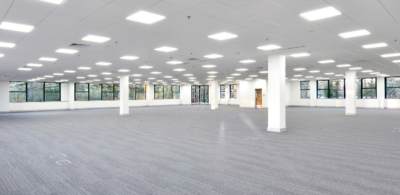Every day, my workplace strategy colleagues and I help businesses around the world create workspaces that are good for people and that drive meaningful business results.
In a collaborative effort, we have brought together our insights and experiences to identify the five major shifts in the workplace that we believe every business needs to consider over the next five years:
- Make employee experience a core part of business strategy
- Build the “Internet of Workplace”
- Create a workplace that makes people healthier
- Ingrain the co-working mentality in real estate strategy
- Enable the agile organization
You might be thinking: My workplace is humming along just fine and 2022 seems so far away. But don’t forget that your space is a valuable asset. In order to optimize that asset and ensure your business stays ahead of the competition, it’s essential to start considering your options now so that the decisions you make are mindful and informed.
In making those plans, it’s critical to define your workplace goals more broadly than just enhancing efficiencies. By redefining the workplace’s value proposition, you can align key stakeholders, create more realistic budgets that provide for all aspects of a successful workplace and closely monitor the metrics that truly reflect your organization’s goals.
So where should you start? Here’s a reminder of the simple steps that will put you on a path to success in each of the five areas of change we anticipate in the coming years.
Make employee experience a core part of business strategy »
Think about what defines your employee experience today and where you have the greatest opportunities to move the needle in meeting the needs of tomorrow’s employees. Do you know what your employees value? Do you know where they consistently experience friction?
If you can create a service-oriented mindset toward employee engagement and true ownership of the employee experience, you can create meaningful change within your organization.
Build the “Internet of Workplace” »
Consider the role that digital connectivity plays in your workplace or your building. Where can you find opportunities for efficiencies or employee engagement by integrating new, sophisticated technologies? How can you address important confidentiality and data security needs in implementing systems that respond to and even anticipate employees’ needs?
Don’t miss the opportunity to make your space “smarter” than your competitors’ and create added value for your employees!
Create a workplace that makes people healthier »
The average person will spend a significant portion of their lifetime in the workplace. How can you ensure that time contributes to your employees’ health and well-being, rather than detracts?
Consider this “Workplace Wellness Checklist” and how each of these features (and more) can play a role in your workplace strategy.
- Access to natural light
- Ergonomic equipment
- Quiet, restorative spaces
- Active noise reduction
- Tall ceilings
- Strategic use of color
- Interior walls made of glass
- Stress-management resources
- Views of natural elements
- Access to healthy food and drink options in cafeterias, vending machines and break rooms
- Indoor air quality
- Design features that encourage walking, such as stairs or the placement of shared resources (think printers and waste bins) in the center of the workspace
- Sit/stand desks or treadmill desks
- Anti-microbial surface protection, particularly in shared environments
- Multi-spectrum or circadian lighting
- Plants and greenery
- Wearable technologies
- Spaces that encourage social engagement
- Management training and resources to encourage healthy work relationships
Ingrain the co-working mentality in real estate strategy »
Think about how you can organize your space needs into categories of “core” (long-term usage, unlikely to change) and “flexible” (likely to change in the short term). As you look ahead to future needs, think about the role that flexible workspaces might play.
As you consider this, it’s important to clearly define the goals you want to reach by using a flexible workspace strategy. Is it achieving flexibility? Encouraging connections to other innovative people and companies? Providing multiple options in a rapidly evolving competitive landscape?
In defining these goals, consider the impact on employee experience and how you can ensure your brand and organizational identity remain strong across the various types of work environments you provide.
Enable the agile organization »
Think critically about the ways your business might change in the coming years. How might agile work practices support your business through increased flexibility, innovation and collaboration? How can you create a workplace that adapts to these organizational changes?
One key is designing your work environment to support intensive collaboration and the needs of the team, which can require a slightly different approach than activity-based working. Here are a few key considerations:
- Provide the right spaces and tools to enable teams of 8–10 to work closely together. Dedicate areas for those teams that facilitate collaboration, such as stand-up areas with whiteboards or “smart boards.” Make it easy to conduct spontaneous meetings, gather around screens or even access whiteboard content remotely.
- Consider the way teams are located and how common areas and pathways through the office can optimize ad hoc connectivity.
- Remember that while agile work is all about intensive collaboration, individual work will always be important. To stay flexible and prevent “room-claiming behavior,” creating quiet areas and library-type areas within open spaces can be more beneficial than a cluster of small concentration rooms.
- Ensure that spaces can be used flexibly and multi-functionally without the need for major refurbishments when activities and team composition change. If designed correctly, an open space can be used for team collaboration and then if needs change, the same area could be used in a different way without significant refurbishment. The key is incorporating techniques like dynamic lighting, digital signage, collaboration screens and reconfigurable furniture to change an area’s look and feel and make it intuitive to use for diverse activities.
By adopting the agile mindset and creating a workplace to support these practices, you will be better placed to not only adapt to the changing needs of your clients and the marketplace, but to stay a step ahead.
Create the Workplace of the Future
These five shifts represent the principle that the workplace is not just a cost of doing business. The workplace must be good for people and intelligently invested in as a critical tool for driving culture, engagement, satisfaction, well-being and productivity.
By thinking about office real estate and workplace design as value drivers rather than line item costs, you can avoid chasing trends and start making informed decisions based on your business objectives and your organization’s cultural aspirations. And that’s a roadmap for success.
For more detail, download the full paper that contains all of the insights our global team has shared in this series of posts: Global Workplace Trends: 5 Shifts Companies Must Make in the Next 5 Years.
This post is part of a series on the five workplace trends that Colliers’ global workplace experts see as the most crucial for companies to align with in the next five years. Be sure to read the earlier installments, download the full white paper and contact the workplace expert in your region for more insights and information.
Contact
Americas
Keith Perske
Head of Workplace Solutions
Keith.Perske@colliers.com
+1 512 673 3653
Australia & New Zealand
Peter Black
Head of Workplace Solutions
Peter.Black@colliers.com
+61 2 9249 2065
EMEA
JanJaap Boogaard
Head of Workplace Solutions
JanJaap.Boogaard@colliers.com
+31 10 412 00 35
North Asia
Truddy Cheung
Head of Workplace Solutions
Truddy.Cheung@colliers.com
+852 2822 0584
Southeast Asia
Samarth Kasturia
Head of Workplace Solutions
Samarth.Kasturia@colliers.com
+65 6531 8685

 Workplace Advisory
Workplace Advisory
 Aaron Jodka
Aaron Jodka
 Amber Merrigan
Amber Merrigan
 Andrew Steele
Andrew Steele